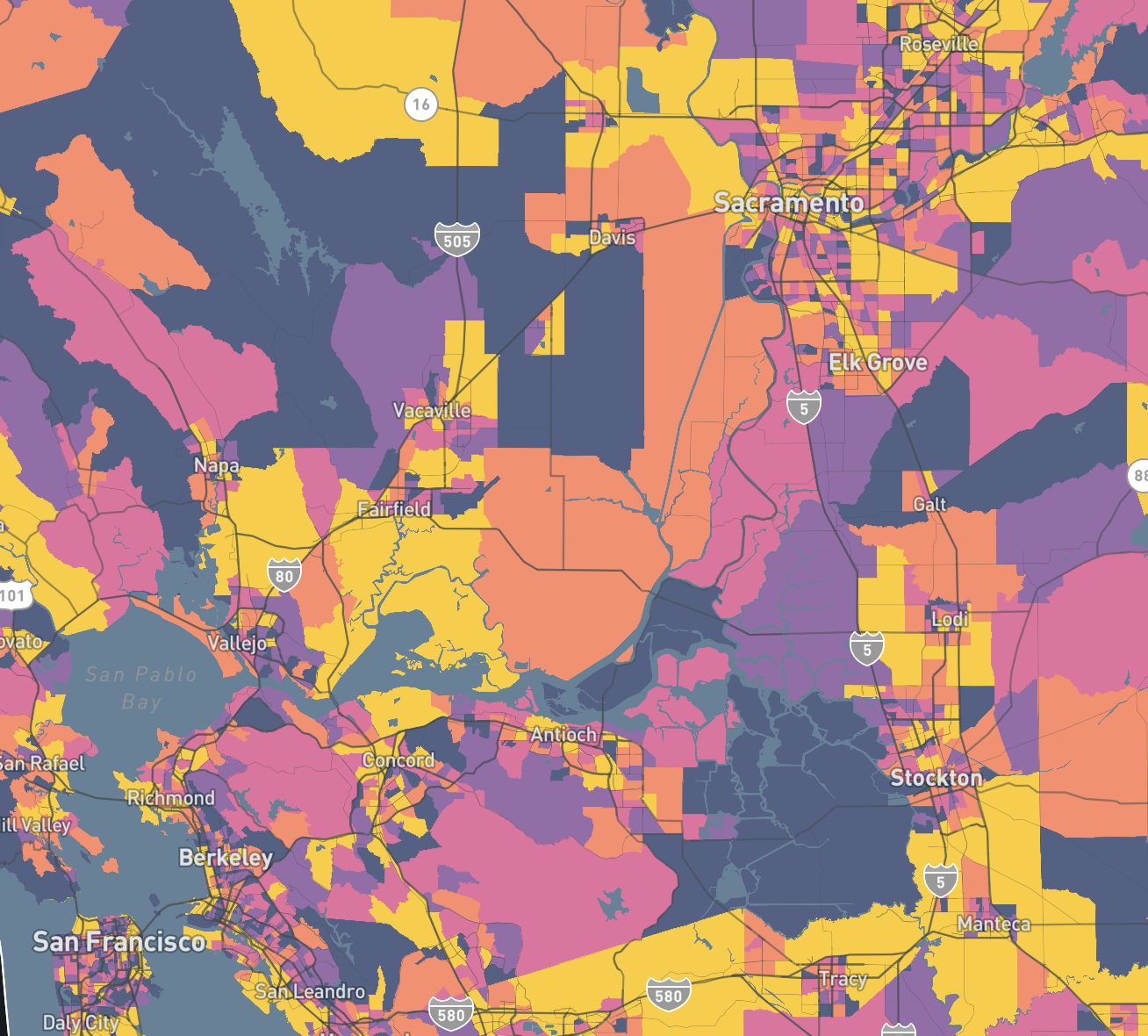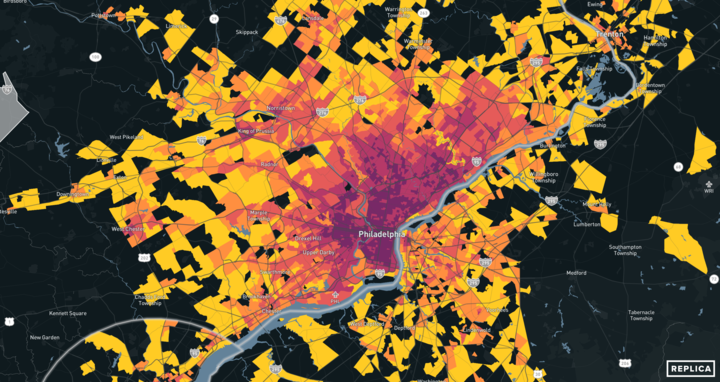Co-Authored by Sam Schwartz Engineering, Nelson\Nygaard, and Replica
Overview
In January 2023, New York’s Metropolitan Transportation Authority (MTA) released Extending Transit's Reach, a strategic action plan to enhance bicycle, pedestrian, and micromobility access to transit stations and other MTA facilities. As noted in the plan, Extending Transit's Reach "[leverages] the industry's latest best practices and extensive data analysis to identify areas of greatest need within [the MTA] system." In this blog post, we discuss the ways in which Replica data supported the existing conditions assessment that set the stage for the plan's bold recommendations. One of the key lessons learned was that Replica data can effectively supplement other data sources to inform a comprehensive understanding of travel patterns throughout a defined study area.
Project Background: The MTA on the Leading Edge
Guided by the principles of transportation equity, stakeholder engagement, integrated planning, and policy and management, the short, medium, and long-term actions outlined in the action plan lay the groundwork to advance a fully integrated, multimodal transportation system. The MTA’s vision for this plan was threefold: make it easier for New Yorkers to reach transit, improve bicycle and pedestrian amenities to better serve more communities, and leverage the MTA’s infrastructure assets to promote safe walking and cycling across the region.
Extending Transit’s Reach builds on the MTA’s ongoing efforts at the leading edge of bicycle, pedestrian, and micromobility integration. In recent years, the agency has piloted a variety of strategies to increase access and facilitate active first- and last-mile connections to commuter rail, bridges, buses, and subway stations. These include the installation of bike racks at 60% of Long Island Rail Road and Metro-North Railroad stations, front-of-bus bike racks on four NYC Transit bus routes, a secure bike parking pilot at Grand Central Terminal, waiving bike permits onboard commuter rail, and wall mounted bike racks on some New Haven line commuter rail trains.
Methodology and the Use of Replica Data
In a collaborative effort to develop the strategic action plan with the MTA, Nelson\Nygaard worked with Sam Schwartz to lead the review and documentation of existing conditions, recent trends, gaps, and opportunities. The team assembled a systemwide station area database, mapping population (resident and employee) characteristics and bike and pedestrian infrastructure conditions and amenities within 1/4- or 1/2-mile walksheds of the MTA facilities (including subway stations, train stations, bus stops, and bridges). The team then worked to analyze contextual demographic data and ridership demand data to create an understanding of an area's improvement priority by both 1) level of need for access and 2) level of demand for access. The result was an Equity Index and a Demand Index; facilities with high values for these indices were then highlighted as key candidates to be considered for improved bicycle, pedestrian, and micromobility access.

While the Equity Index evaluated census demographic factors previously used in other MTA projects, the team developed a curated set of demographic, built environment, and travel factors to create the Demand Index, which incorporated mode-specific travel volumes from Replica Places. The goal for the Demand Index was to identify areas of the MTA's facilities that have a high demand for intermodal connectivity. The Demand Index divided stations into five tiers based on eight weighted demand factors, and one of the factors was density of bicycle trips, which was derived from bicycle travel data from Replica.
In the absence of a comprehensive network of bicycle counters, Replica data was identified as a reliable source for quantifying bicycle trip volumes throughout the study area. Replica’s methodology involves developing a synthetic population, training three types of travel behavior models (i.e., activity sequence model, location choice model, and mode choice model), running simulations of the behavior models applied to the synthetic population, and finally calibrating the outputs to improve quality. (For more information, refer to Replica’s summary methodology here.) After deciding to use Replica data to inform the analysis, the team chose to use the Fall 2019 Places season because it corresponded to a pre-pandemic baseline, thereby avoiding subsequent seasons’ data that might have been skewed due to pandemic-era travel patterns.
As shown in the map below, the team used Fall 2019 bicycle travel data from Replica Places to establish an understanding of bicycle trip volumes throughout New York City. This was done by creating a Places Study for the North Atlantic megaregion using a typical Thursday in Fall 2019, applying a primary mode filter (to specify biking), and applying both a trip origin filter and trip destination filter for New York City. The team subsequently used R to summarize the number of bike trips per census block group, and brought the data into a GIS platform for further spatial analysis (i.e., walksheds were created using the Network Analyst tool in ArcGIS based on the available walking network). Using this approach, the team was able to evaluate the number of bicycle trips that started and ended in the walksheds of the MTA’s facilities.

Action Plan Recommendations and the Relevance of Replica Data
The recommendations in Extending Transit’s Reach are organized around five categories and include specific strategies and actions that help achieve the plan’s vision and goals, anchored by the findings from the data analysis. For example, one strategy under the Station Access and Mobility category is to improve bike parking (both standard and secure) at key subway stations and bus stops, and the aforementioned Demand and Equity Indices can help to inform the prioritization of different locations for improvements.
Of note, one strategy under the Policy, Program Administration, and Performance Management category is to enhance bicycle, pedestrian, and micromobility data collection. In conjunction with other datasets, seasonal data from Replica Places could be a useful resource in advancing that strategy. Moreover, near-real-time from Replica Trends could be leveraged to monitor change over time, both before and after implementation of micromobility improvements at the MTA’s facilities. This has the potential to show how investments can result in changes to bicycle use and transit ridership, thereby supporting the transformational vision of the strategic action plan.
Conclusion
The collaborative work to develop Extending Transit’s Reach is indicative of the MTA’s leadership on the issue of bike, pedestrian, and micromobility integration. Just as Replica Places data informed the Demand Index as a core component of the plan, data from both Places and Trends can similarly play a key role in supporting implementation efforts. When integrating Replica data with other data sources, the sky’s the limit on what’s possible in advancing this strategic action plan.
Do you want to learn how to view biking and walking patterns in Replica Places so you can complete your own analyses? Visit this “How to” resource in our online Help Center (Note: You must be logged in to Replica to access this page).
Do you want to learn about other use cases for active transportation data from Replica, such as planning for roadway safety? Visit this link to access our recent Safe Streets for All (SS4A) webinar recording.
Would you like to share a success story of integrating Replica data into one or more of your projects? Email support@replicahq.com to provide details.








